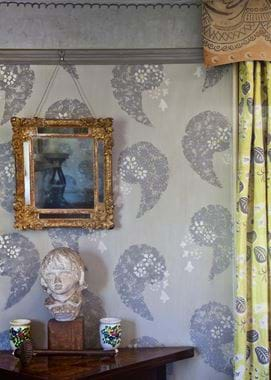Book club: Charleston, A Bloomsbury House and Garden
Book club: Charleston, A Bloomsbury House and Garden
Nestled in the East Sussex countryside just outside Lewes is Charleston, originally the summer sanctuary and now spiritual home of the group of artists, writers, commentators and creatives that have become known as the Bloomsbury Group. Though closed to the public for now, Charleston is beautifully profiled in the recently updated book Charleston: A Bloomsbury House and Garden by Quentin Bell and Virginia Nicholson. Not only do we see the home and its gardens room-by-room, but Bell and Nicholson also share the stories that make Charleston so incredibly special.
Their lives have been told and retold over the years and the surviving interiors and gardens reflect the group’s approach to art and design in its fullest form, not just through what we see but through the tales behind the paint. When the oval mirror above the fireplace in the garden room was smashed, a mural was painted in its place and when a picture was sold, a copy was painted as a reminder. In the kitchen, on the tiles behind the Aga, we learn of the family’s cook Grace Higgens, under the window in what is now the library, Henry the lurcher is depicted. In the studio, a grand Dutch walnut cabinet is filled with some of the faces of famous women from the 50 plates painted by Vanessa Bell and Duncan Grant, originally commissioned by Kenneth Clark. The collection featured 49 women and one man (Grant), including Elizabeth I, Mary Queen of Scots and Emily Bronte, as well as more contemporary faces like Greta Garbo, Pre-Raphaelite model and artist Elizabeth Siddal and Vanessa’s sister, the writer Virginia Woolf, as well as Vanessa herself.
Vanessa and Duncan’s art in all its forms can be found throughout the house. Painted on door panels and furniture, fireplaces, walls and tiles, and also textiles. These play a big part in the rooms, bringing texture and pattern, and can be found at the windows as curtains and pelmets as well as on upholstered Venetian chairs and informal armchairs. On walls, repetitive stencilled prints act as wallpaper adorning the dining room and as borders, embellishments and makeshift murals.
Out in the garden, art and nature exist in harmony, with the walled garden populated by a host of exuberant plants, Quentin’s sculptures and mosaics made from broken pottery. The edge of the formal pond is embellished with hand painted tiles and amongst the flora throughout the garden is a vast collection of art school plaster casts amassed by Duncan and Vanessa. Amongst the more contemporary pieces is Quentin’s eye-catching Levitating Lady and his somewhat hidden redbrick sphinx-like seated woman called Spink.
Charleston’s interiors and garden are inspiring and immersive, offering the most complete insight into the group’s approach to interiors, design and art. Despite being productive throughout the inter-war years, little remains of their commercial work that was completed as part of artist and art critic Roger Fry’s Omega Workshop, the company that brought the artists together as a commercial entity. There’s no doubt that the Charlestonians introduced us to the finishes and techniques that we would call painterly today, and their use of earthy neutral shades punctuated with bright pops of colour continues to inspire designers.
Charleston today
Whilst Charleston is closed, it’s still possible to support the Charleston Trust’s work to preserve and conserve the house. The online Charleston shop sells fabrics designed by Vanessa Bell and Duncan Grant by the metre, an exclusive range of home products designed by artist Cressida Bell, and Virginia Nicolson’s new edition of Charleston: A Bloomsbury House and Garden. You can also support by donating to the Trust’s current appeal to help safeguard the house and garden.
Visit Charleston Trust for more information and the Charleston online shop.










